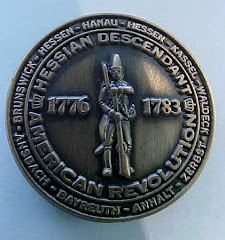
Inside the Henkel house, Treysa.

In the cellar of the Henkel house, showing the stone vaulted ceiling.

In the cellar showing old winding stone stairway up to the ground floor. Nearby is the former entrance to a tunnel.
We met our new friends again after breakfast on Day 3, and were given photocopies of Treysa church records. These included the marriage of Nicholas’s grandparents Johann Heinrich Henckel and Elizabeth Lotz in 1722, Nicholas’s parents Johann Herman Henckel and Anna Elizabeth Otto in 1752, and the baptism/christening (including birth date) of Nicholas himself in 1755. We were also given copies of some house records from the local Treysa archives. Among these were all owners of the Henkel house from 1623 to the present. This showed Henkel families owning the house continuously from 1730 to 1978. However, these Henkels were Bakers, not Shoemakers. Please see again the reference in the Treysa - Day One posting to the two families of Henkels in Treysa. You will recall that Nicholas’s widowed father remarried when Nicholas was 5 or 6 years old to Susanna Henkel, and that she was one of the "Baker Henkels", thus connecting the two families.
The previous day, our Genealogist friend had shown us a book entitled "Das Tagebuch des Sockenstrickers Johann Valentin Asteroth aus Treysa (1776-1831)". It was the diary of a soldier, born in Treysa, which was kept during the time of the American Revolution. His experiences and details of life as a soldier in Ziegenhain and America, and the journey to and from, would have been almost identical to that of Nicholas. Today, our friend insisted that he give us this book to further help with our research.
Before leaving to visit the town again, we showed a copy of family trees of both Evelyn and I to point out other common German ancestors in our past. These included not only Nicholas Henckel, but also John (Eichorn) Acorn and Peter (Baum) Ballem. As soon as we mentioned Peter Baum, we heard the word "Juden", Jewish. There had indeed been Baum families in Treysa, and that they had been Jewish. We mentioned that 32 year old Nicholas Henckel and family had left Germany for Prince Edward Island, Canada in 1787, and that young Peter Baum, a boy of about 12, was with them. They were quite excited and pleased about the story of a German family helping a young Jewish boy. Later that morning we were given a document for another house in Treysa which had been sold by an Abraham Baum in August 1937, presumably shortly before they left Hitler’s Germany. Our friends were going to dig deeper to see what might be found of any Baum in Treysa about 1787, specifically for any mention of Peter, and a possible reason for a connection between the Baum and Henckel families.
After thanking our friends very much for their help, we set out to see if we could get inside the Henkel house. The ground floor is now a bar, Bistro Copas, and we went in to have a coffee as soon as they opened that morning. The lady did not speak English, but went next door to fetch someone who could. Who should appear but the same man whom we had met each of the previous two days, and who owned the Henkel house. He quickly excused himself, returning with a photo of the interior as it had been before extensive restoration in the 1990s. He also had a flashlight, and proceeded to take us on a tour of the cellar below the house. It had a vaulted stone ceiling and winding stone stairs that had previously lead up to the ground floor. There had also at one time been a tunnel which lead from the cellar though the lower levels of many other buildings down toward the river a great distance away. After taking more photos, he joined us for coffee in the Bistro Copas.
After picking up our luggage at the Hotel Stadt, and a final thanks and farewell, we were off to catch the noon train for Frankfurt and our return home. We cannot say enough about how friendly and helpful the people were that we had met. Without their efforts we still would have had a pleasant visit to the area of our ancestors. But because of how friendly they were and all that they did for us during our short stay, we have gained so much more information about Nicholas, his family, the town of Treysa where he lived, and the fortress of Ziegenhain where he was a soldier, than we might have hoped for. The people, scenery, and history were all first class We have made numerous friends, and hope to visit again. If you ever get a chance to visit Germany, we would highly recommend including a visit to Schwalmstadt if at all possible.
While this visit is finished, the work is not. In the coming days and weeks the information provided in German will be reviewed for additional details on Nicholas, his family, and his community. And the new information will be incorporated into what was previously known to give a revised and updated look at this part of our family. Stay tuned for more updates. Meanwhile, what do you think of the findings so far? Do you have any observations, questions, or suggestions for lines of further research? Please add you comments below, or email to me at demacdonald@pei.sympatico.ca .







